Apple variety Dream
At the Muchurin Institute of Horticulture, the Dream apple tree was bred. The main goal of breeders is to obtain a variety that would not be exposed to low temperatures and diseases. Saffron and White Naliv were used as progenitors.
- Characteristics of the variety
- The appearance of the tree and fruit
- Taste characteristics
- Yield
- Winter hardiness
- Pollination
- Disease resistance
- Advantages and disadvantages
- Planting varieties
- Choosing the right place
- Preparation of seedlings
- Landing scheme
- Variety care
- Watering
- Top dressing
- Pruning
- Shelter for the winter
- Preventive procedures
- Features of ripening and fruiting
- Flowering time
- Ripening terms
- Harvesting and storage
- Subspecies and variants
- Dwarf
- Semi-dwarf
- Growing regions
- Testimonials
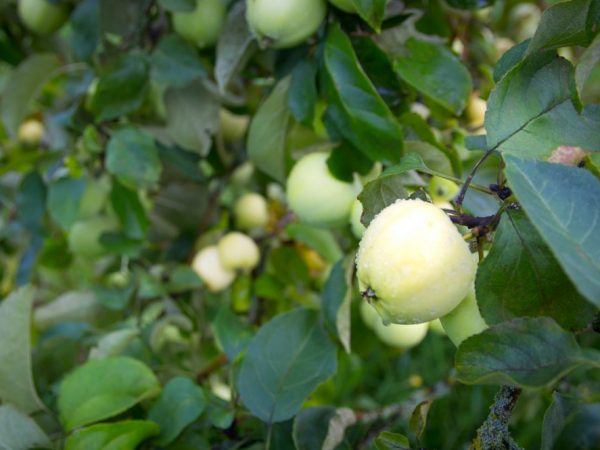
Apple variety Dream
Characteristics of the variety
In the process of selection, the institute's workers were able to breed a frost-resistant apple tree, the variety was named Mesta. The tree has a strong immunity, it protects against fungal infections and parasites.
The popularity of this variety is justified by the low whimsicality of care. Growing a culture is within the power of every gardener.
The appearance of the tree and fruit
The height of the tree is only about 3 m. In rare cases, they grow up to 4 m.
Barrel description:
- smooth;
- strong;
- reddish gray bark.
Shoots and side branches are green with small green blotches. The crown is wide, oval in shape. The peculiarity lies in the rapid growth of branches. If you do not tie or cut off the shoots in time, the crown will lose its shape.
Description of fruits:
- medium or large size apples: approximate weight of each 100-300 g;
- round shape;
- color - yellow, with a slight green blush;
- if grown in sunny and warm areas, some fruits will be red in color.
Taste characteristics
The pulp is white. It has small red fibers that give it an unusual appearance. The structure of the flesh is loose, melts in the mouth when consumed.
The fruits are sour to taste, with a slight sweetness. If the culture is properly cared for, the sweet taste will prevail.
Yield
Up to 120 kg of selected products are collected from each tree. If the crop is properly cared for, the yield can be increased to 150 kg.
If self-pollinated high-yielding crops are planted nearby, yield indicators reach 200 kg per tree.
It is better to store the harvested fruits in cool rooms so that they retain their commercial qualities for a longer time.
Winter hardiness
The tree has good frost resistance: it can withstand up to -30 ° C.
Since this variety was bred specifically for the northern regions of the country, when planting, young seedlings are resistant to temperature extremes. Planting is possible at rates of -5-7 ° C.
Pollination
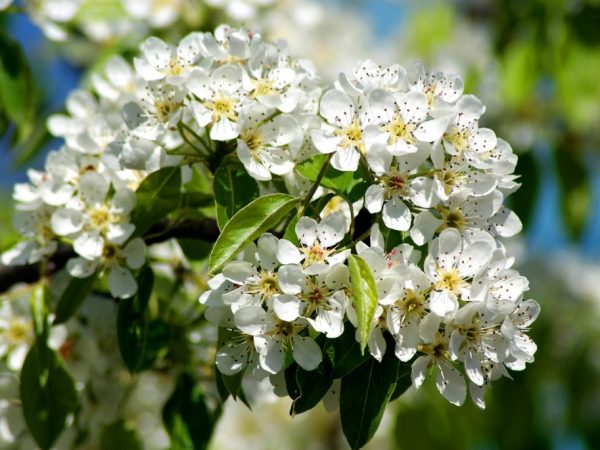
The Dream variety needs pollinators
The Dream variety does not possess self-pollination properties, so additional plants are planted next to the apple trees. If you are unable to plant pollinators, do the pollination yourself.
To do this, it is enough to collect pollen from self-pollinated crops that are planted in another area and scatter them close to the tree.
The best pollinators are Melba and Antonovka.
Disease resistance
The variety has good immunity, which allows it to resist the effects of diseases and pests. Resistance to scab and powdery mildew is observed.
In the central and southern regions, the tree is affected by ticks. An effective fight against these parasites is carried out with the help of chemicals.
Advantages and disadvantages
The main advantages of the apple tree include:
- high commercial qualities;
- pleasant taste;
- fast ripening times;
- frost resistance.
Among the shortcomings, it is noted: the obligatory planting of other pollinators and cracks in the fruits with poor-quality care. As well as unstable fruiting and short shelf life.
Planting varieties
For cultivation, a seat is prepared in advance. If necessary, replace the topsoil to make it more fertile.
After preparation, a planting hole is dug. The planting process is carried out both in spring and autumn.
Choosing the right place
Areas that are well lit by the sun are considered suitable. It is important to provide wind protection. A month before the intended planting, they dig a hole and prepare it.
- The diameter of the pit is 60 cm.
- Depth within 70 cm.
- A crushed stone drainage is installed at the bottom.
- Humus and wood ash are poured over the drainage system.
Autumn planting is carried out after all the leaves from the trees have fallen. This condition helps the plant to acclimate and adapt to outdoor conditions. If you decide to plant plants in the fall, you cannot feed the soil with nitrogen-containing preparations. If this is done, the kidneys will swell and deform from low temperatures.
Planting in spring is carried out after the snow melts. Give the soil time to warm up to a temperature of 5-7 ° C. Try to plant a crop before sap flow begins in the seedlings. For this, the hole has been prepared since November so that the soil settles.
Immediately after the procedure, the seedling is fed with complex fertilizers.
Preparation of seedlings
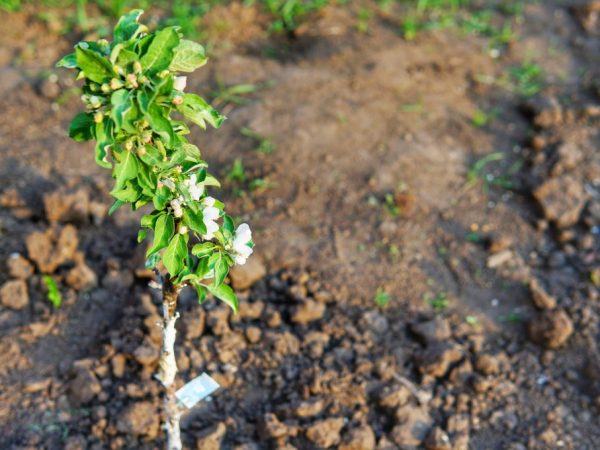
When buying a seedling, pay attention to the condition of the roots.
When choosing and preparing seedlings, follow the recommendations.
- Buy only copies that are at least 2 years old. They have an increased survival rate in the open field.
- To transport the planting material, the roots are placed in a wet cloth.
- If dry roots are visible, they are placed in warm water for literally a few days before planting.
- Remove leaves from the seedling so that no more than 2 of them remain on each branch. This will improve root formation. The culture will not waste nutrients on the formation of foliage.
Landing scheme
After preparing the soil and digging the hole, carry out a number of simple actions.
- Dig the bottom of the planting pit with a shovel and mix the separated soil with humus, egg shells and minerals (200 g of nitrogen, 100 g of potassium and 300 g of superphosphate).
- Before planting, 2 buckets of water are poured into the hole and given time to soak.
- A seedling is placed in the pit and its root system is spread.
- The root collar is left above the ground (about 5 cm).
- Sprinkle the seedling with soil and tie it to a support (wooden or metal). The support should be higher than the young tree.
- Water the planting with 20 liters of warm water.
If you are planting several trees of this variety, try to do it at a distance of 4 m from each other. This distance is also kept when planting 1 tree on an area where there are other crops.
It is impossible for neighboring plants to intertwine with each other or shade each other. This reduces the yield and the immune system of the tree.
Variety care
Taking care of apple crops is easy. They need a standard procedure that every gardener knows about.
To grow a beautiful tree that will yield high yields annually, it is enough to water it on time, feed it with fertilizers and cut off damaged shoots.If you live in the regions of the Urals or Siberia, do not forget about sheltering the culture for the winter.
Watering
The frequency of irrigation of the beds depends on which region you live in. The timing of irrigation is influenced by the climatic conditions of the environment.
- In the central regions, watered every 30 days.
- For the southern regions, this interval is reduced to 20 days.
- In the north - every 2 months.
It is necessary to suspend the procedure at the end of summer so that the plant prepares for a cold snap. After watering, after 5-7 days, the soil is loosened and weeds are removed.
Caring for the near-stem circle plays a huge role, since it helps to protect the culture from viruses, diseases and parasites. Regular loosening of the soil ensures full air exchange in the root system.
Top dressing
Further care should also include fertilization. Top dressing is carried out 2 years after planting.
In the spring, you need to add ammonium nitrate at the root. To do this, dilute 300 g of the drug in 10 liters of warm water and pour 5 liters of solution under each bush.
In the fall, the plant is fed with potassium nitrate (500 g per 10 l of water) and superphosphate (400 g per 10 l of water). At least 8 liters of fertilizer are poured under each tree.
Pruning
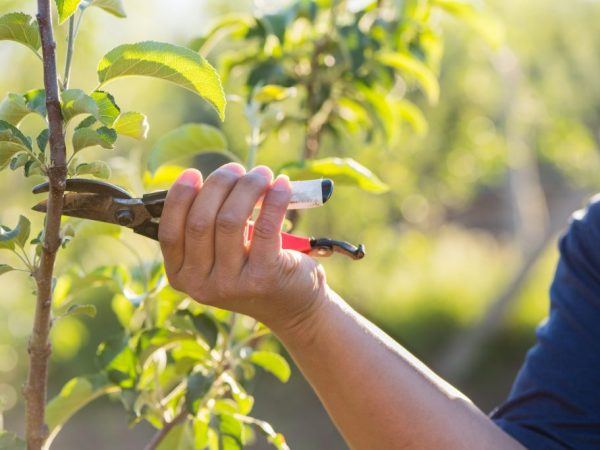
Once every five years, the crown must be formed
There are several types of trimming.
- Formative.
- Sanitary.
The crown is formed with an interval of 5 years. To do this, cut off the branches that are out of shape. Formative pruning is carried out in the spring before bud break. Sanitary pruning is required at intervals of 7 years after planting. It is carried out 2 times (in spring and autumn). Remove all dry parts of the tree and sore and damaged areas. All places of the cut are watered with garden varnish to seal the wound. This increases protection against pests and diseases.
Shelter for the winter
To protect the young crop from rodents that look for food in winter, the trunks need to be wrapped with spruce branches. More mature plants, from 5 years old, are treated with limestone solution. With its help, bacteria and pests will not penetrate into the trunk.
Despite the resistance of the variety to frost, it is better to prepare it for winter. Additional protection consists of the following procedures:
- winter watering (the last time water is poured in at the beginning of August);
- hilling the trunk;
- mulching the trunk circle with humus.
Preventive procedures
Despite its good immunity, the Dream apple tree can be exposed to some diseases and parasites.
Brown spots appearing on apples will help determine the presence of fruit rot. It is impossible to eliminate the signs of the disease, therefore, every month, carry out preventive treatments using Horus (40 g per 5 L of water) or Bordeaux liquid (50 g per 4 L of water).
If you notice white bloom on the leaves of the tree, the culture has been affected by powdery mildew. Copper preparations help to fight it - Topaz (100 g per 5 liters of water) or Skor (70 g per 10 liters of water).
The appearance of a brown bloom on the foliage indicates the presence of scab. Prevention consists in spraying with Fitolavin solution (50 g per 6 l of water). It is necessary to fight this disease with Fitosporin or Horus (the preparations are diluted in warm water clearly according to the instructions).
There are 2 types of parasites.
- Fruit mite. Untimely destruction of this parasite leads to a decrease in yield. Treatment with copper sulfate (40 g per 6 liters of water) helps to get rid of it.
- The moth is capable of destroying most of the future harvest. To prevent this, trees are treated with Fitosporin every week (according to the instructions).
All treatments are carried out in spring or summer. The interval depends on the extent of the lesion. Insecticidal spraying is stopped a month before harvest.
Features of ripening and fruiting
Each culture has its own ripening and fruiting dates. Times vary depending on the region of planting and the quality of the care procedures.
The dream belongs to early cultures.You can harvest for the first time 3 years after placing the seedling in a permanent place (subject to all the recommendations of agricultural technology).
The yield is influenced by the weather. If the winter was cold and the summer was hot, then the number of fruits will be lower.
Flowering time
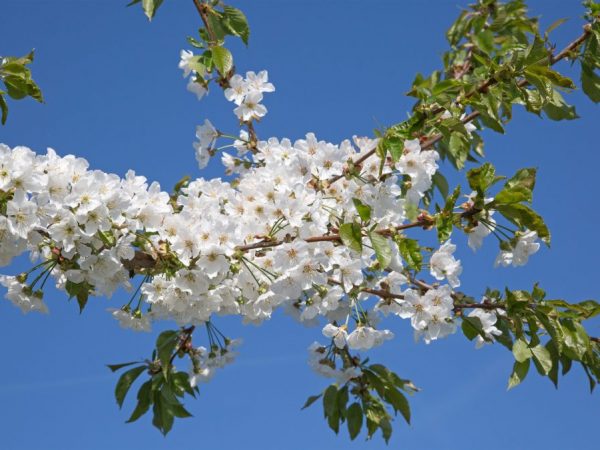
The apple tree blooms white
The flowering period begins in mid-April. Lasts until the end of May. The color of the inflorescences is white.
The aroma is pleasant, sweet, pronounced. At the end of May, when the flowers fall, the fruit sets.
Ripening terms
The culture ripens in August. The duration of the harvest is 2-3 weeks.
If you do not provide the culture with proper care, the fruits crack and fall off. As a result, the ripening time is reduced to 1 week.
Harvesting and storage
You can harvest a ripe crop already at the end of August. Try to pick only large fruits at first to allow the small ones to pour. Do this carefully so that the fruit does not fall or break.
It is better to store products in a cool room, similar to a basement. If you live in a city, you can transfer to the balcony, periodically opening the window for fresh air.
Storage periods are short, because the pulp is loose in consistency.
Subspecies and variants
This type is considered the most common, but there are other subspecies of this culture that are popular among domestic and foreign gardeners.
Each of these subspecies has advantages and disadvantages. Having studied their characteristics, it is easier to choose a suitable variety.
There are several common rootstocks that make growing easier.
- Dwarf.
- Semi-dwarf.
Dwarf
This popular stock was grafted onto a dwarf apple tree. The peculiarity lies in the compact size.
The advantages of this type:
- high level of productivity;
- small size of the crown;
- commercial and taste qualities.
The difference between the dwarf rootstock and the original lies in the absence of a tendency to fluctuations in fruiting. The disadvantage is undeveloped roots that adhere close to the surface of the earth. To prevent it from freezing in winter, you will need to cover it with insulated materials (agrofibre, humus and straw).
Fruiting lasts no more than 10 years, and the first crop is harvested only 8 years after planting.
Semi-dwarf
Plants that have been grown on semi-dwarf rootstocks are used as decorations in the garden. Their neatness is attracting more and more attention.
Due to its unpretentious care, the semi-dwarf rootstock is grown even by beginners in the field of gardening, and its frost resistance contributes to high yields.
Growing regions
The highest yields are observed if this variety is planted in regions with warm and temperate climates.
The plant quickly acclimatizes in the open field if there is little rainfall in winter. Grow on dwarf or semi-dwarf rootstocks in the north-west of the country.
This variety is often found in the Moscow region. Suitable for planting in the Urals and Siberia, because it tolerates low temperatures well.
Testimonials
The Dream variety has earned positive reviews: the apples are very tasty and they look very appetizing. A large number of positive assessments are based on the high sustainability of this
Gardeners make fresh juices or jams from the produce, which will give a feeling of pleasure and warmth on cold winter days.

